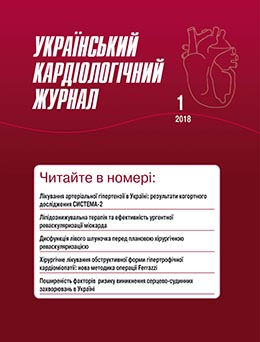Effect of various regimens of lipid-lowering therapy on the efficacy of urgent myocardial revascularization and development of left ventricular remodeling in patients with acute coronary syndrome with ST segment elevation
Main Article Content
Abstract
The aim – to evaluate the effect of different regimes of lipid lowering therapy on the effectiveness of urgent myocardial revascularization and the development of cardiac remodeling in patients with acute coronary syndrome with ST segment elevation (STEMI).
Material and methods. The study involved 135 STEMI patients admitted an average of 4.5 hours after symptoms onset and treated with primary percutaneous intervention. Lipid-lowering treatment was prescribed immediately after presentation. Patients were randomly assigned to one of four groups treated by moderate (group I and group II) or high (group III and group IV) intensity lipid-lowering therapy. Group I (26 patients) was assigned to atorvastatin 10 mg / ezetimibe 10 mg combination, group II (24 patients) – to atorvastatin 40 mg, group III (42 patients) – to atorvastatin 40 mg / ezetimibe 10 mg combination, and group IV (43 patients) – to atorvastatin 80 mg. Echocardiography was performed in all the patients during first 24 hours after symptoms onset and 90 days after STEMI development. Left ventricular (LV) dilatation was defined as at least 25 % increase of end-diastolic volume.
Результати. Пацієнти з III і IV груп показали тенденцію до зниження після 3 місяців лікування дилатації ЛШ після ЛІ (Р <0,1). У нашому дослідженні застосування високоінтенсивної ліпід-знижувальної терапії зменшило ризик ремоделювання ЛШ на 30% (р <0,05), що також було пов'язано зі значно більш високим зниженням ЛНП. Не маючи початкових відмінностей, на 90-й день середній рівень ЛНП становив 1,63 ± 0,40 у хворих з високою інтенсивністю лікування проти 2,21 ± 0,30 ммоль / л у пацієнта з терапією середньої інтенсивності (Р <0,01).
Висновок. Використання високоінтенсивної ліпід-знижувальної терапії з досягненням цільових рівнів ЛНП після СТЕМІ може знизити частоту дилатації ЛШ після ЛІ.
Article Details
Keywords:
References
Parkhomenko OM, Amosov KM, Dzyak GV, Knyshov GV, Kovalenko VM, Netyazhenko VZ, Koval OA, Copies MP, Sokolov YuM, Todurov BM, Tashchuk VC, Shumakov IN, Іrcın OI, Sokolov MYu, Goloborodko BI, Kozhukhov CM, Lutai YaM, Shumakov OV, Vatutin MT, Lutai MI, Rishko MV, Sereduk NM, Sіrenko YuM, Tseluiko VY. Recommendations Assorted cardiology of Ukraine. Inoculation of patients with gastric coronary syndrome of the ST segment. Ukrainskyi kardiolohichnyi zhurnal [Ukrainian journal of Cardylogi] 2013;Additions2:3-51(in Ukr).
Almalki ZS, Guo JJ, Alahmari A, Alotaibi N. Cost-effectiveness of Simvastatin Plus Ezetimibe for Cardiovascular Prevention in Patients with a History of Acute Coronary Syndrome: Analysis of Results of the IMPROVE-IT Trial. Heart Lung Circ. 2017 Jun 15. pii: S1443-9506(17)31261-1. doi: 10.1016/j.hlc.2017.05.139
Brener SJ, Dizon JM, Mehran R, Guerchicoff A, Lansky AJ, Farkouh M, Brodie B, Guagliumi G, Witzenbichler B, Fahy M, Parise H, Stone GW. Complementary prognostic utility of myocardial blush grade and ST-segment resolution after primary percutaneous coronary intervention: analysis from the HORIZONS-AMI trial. Am Heart J. 2013 Oct;166(4):676–83. doi: 10.1016/j.ahj.2013.07.025. Epub 2013 Sep 13.
Brener SJ, Dizon JM, Mehran R, Guerchicoff A, Lansky AJ, Farkouh M, Brodie B, Guagliumi G, Witzenbichler B, Fahy M, Parise H, Stone GW. Complementary prognostic utility of myocardial blush grade and ST-segment resolution after primary percutaneous coronary intervention: analysis from the HORIZONS-AMI trial. Am Heart J. 2013 Oct;166(4):676-83. doi: 10.1016/j.ahj.2013.07.025. Epub 2013 Sep 13.
Gibson CM, Cannon CP, Murphy SA, Ryan KA, Mesley R, Marble SJ, McCabe CH, Van De Werf F, Braunwald E. Relationship of TIMI Myocardial Perfusion Grade to Mortality After Administration of Thrombolytic Drugs. Circulation 2000;101:125–130.
Gibson CM, Cannon CP, Murphy SA, Ryan KA, Mesley R, Marble SJ, McCabe CH, Van De Werf F, Braunwald E. Relationship of TIMI myocardial perfusion grade to mortality after administration of thrombolytic drugs. Circulation. 2000 Jan 18;101(2):125–30.
Kampinga MA, Nijsten MW, Gu YL. Is the myocardial blush grade scored by the operator during primary percutaneous coronary intervention of prognostic value in patients with ST-elevation myocardial infarction in routine clinical practice? Circ Cardiovasc Interv 2010;3:216–223.
Ptaszyńska-Kopczyńska K, Sobolewska D, Kożuch M, Dobrzycki S, Sobkowicz B, Hirnle T, Musiał WJ, Kaminski K. Efficacyo invasive treatment and the occurrence of cardiac ruptureinacute ST−elevation myocardial infarction. Kardiologia Polska 2011;69,8:795–800.
Steg PG, James SK, Atar D, Badano LP, Blömstrom-Lundqvist C, Borger MA, Di Mario C, Dickstein K, Ducrocq G, Fernandez-Aviles F, Gershlick AH, Giannuzzi P, Halvorsen S, Huber K, Juni P, Kastrati A, Knuuti J, Lenzen MJ, Mahaffey KW, Valgimigli M, van 't Hof A, Widimsky P, Zahger D. ESC Guidelines for the management of acute myocardi-al infarction in patients presenting with ST-segment elevation. The Task Force on the manage-ment of ST-segment elevation acute myocardial infarction of the European Society of Cardiology (ESC) European Heart Journal 2012;33:2569–26.
Stone GW, Peterson MA, Lansky AJ, Dangas G, Mehran R, Leon MB. Impactof normalized myocardial perfusion after successfulangioplasty in acute myocardial infarction. J Am Coll Cardiol. 2002;39:591–597.

